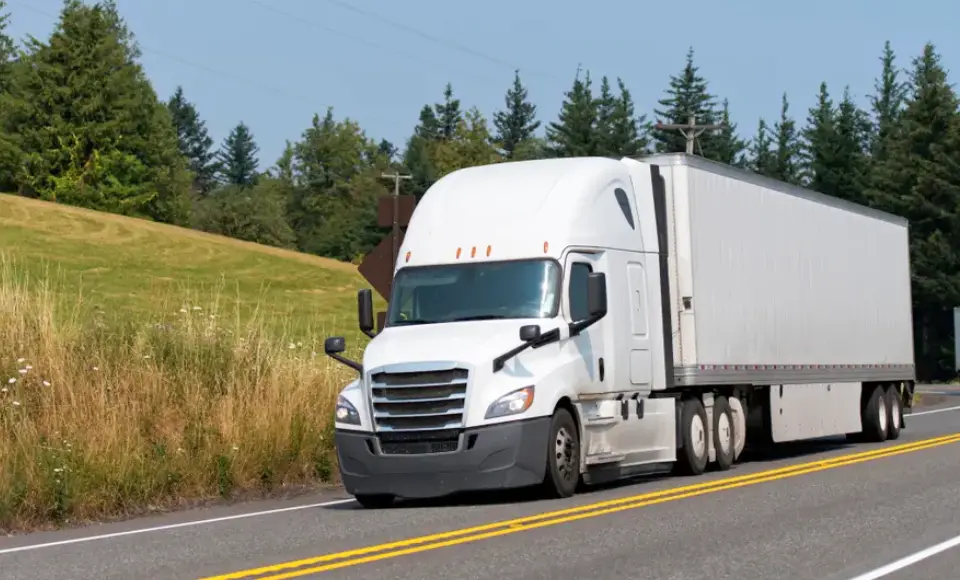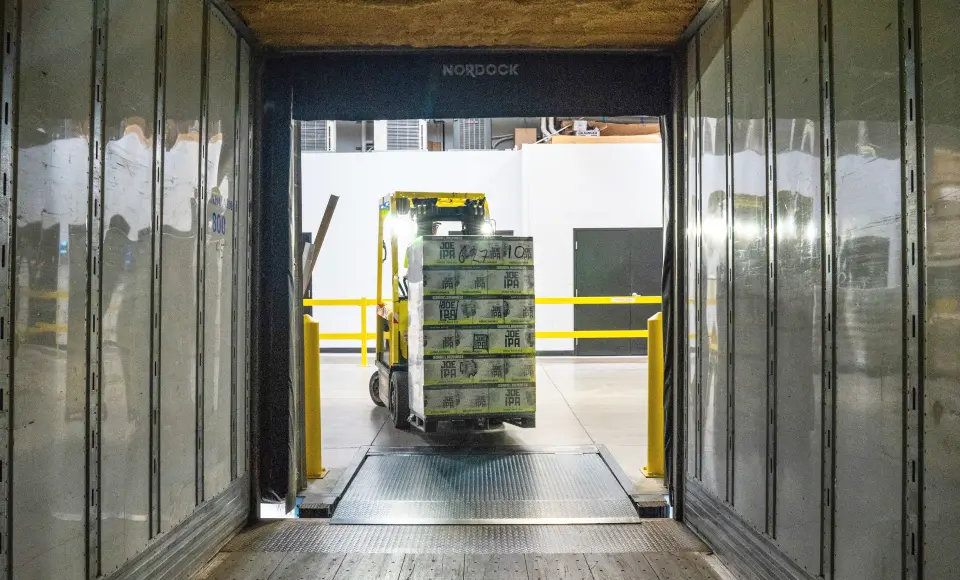The trucking industry is incredibly versatile, especially with regard to the types of semi-trailers shippers and receivers can use to transport various types of cargo. Popular options include flatbed trailers, reefers, tanker trailers, and lowboy trailers, to name a few. However, dry van trailers are among the most common types found in the industry today.
A dry van trailer is a fully enclosed semi-trailer designed to transport palletized, boxed, or loose freight. The weather-resistant and secure compartment shields cargo from external elements, theft, and damage during transportation.
In this article, we’ll dive deeper into dry van trailers, explaining their functions, dimensions & capacity, as well as their pros and cons. We’ll also take a closer look at their pricing and the types of cargo these trailers are suitable for.
What Is a Dry Van Trailer?
Dry van trailers, also known as box trailers, are semi-trailers typically used to transport consumer goods, food and beverage products, medical supplies, and even construction materials. These trailers have a rigid, cuboid shape and are constructed using various materials, including galvanized steel and aluminum.

Many modern dry van trailers feature wooden flooring to improve cargo handling and storage. What sets these trailers apart from other trailer types is that they’re fully enclosed. The cargo inside is shielded from outdoor elements, including rain, sunlight, debris, etc.
Moreover, they don’t have temperature or humidity control, so they’re suitable for transporting perishable goods. Some do have built-in ventilation to limit the amount of heat produced inside.
Overall, dry van trailers are among the most popular trailer types in the industry due to their versatility, security, and cost-effectiveness.
How Are Dry Van Trailers Loaded and Unloaded?
Dry van trailers are like permanently attached shipping containers. They feature either two swing doors or a roll-up door at the rear that can be accessed for loading and unloading. Below are steps explaining this process in detail.
- Cargo Inspection – The first step involved in loading cargo into a dry van trailer is inspection. This is done to ensure the cargo is packaged and labeled according to industry standards and safety regulations.
- Safely Positioning the Trailer – Next, drivers safely park and position the trailer in a level and secure area to ensure it’s aligned with the loading dock or ramp. Moreover, they check the surroundings to ensure there are no obstructions when opening the doors or operating different equipment.
- Carefully Opening Doors One at a Time – Once the trailer is safely positioned, the handlers release the door latches and carefully lift the roll-up door or swing one door slightly. Then they need to visually inspect the cargo and ensure nothing falls out before opening the doors fully.
- Loading the Trailer – Once the doors are open, the handlers use the appropriate equipment, such as a pallet jack or forklift, to load the cargo into the trailer. Operators are professionally trained and make sure to distribute the weight evenly and take necessary precautionary measures to secure the cargo, such as using strips or chains. Moreover, when hauling loose cargo for multiple deliveries in a single trip, they practice first in, last out (FILO).
- Closing the Doors – As soon as the cargo is loaded, the handlers inspect the trailer to ensure they’re secured and positioned correctly. Depending on the shipment or location, they can seal the trailer for additional security.
- Unloading the Trailer – To unload the trailer once they arrive at the destination, handlers simply follow the same steps above, such as opening the doors, using appropriate equipment to unload the cargo, and closing the doors once the process is complete.
Dry Van Trailer Dimensions & Capacity
Dry van trailers are available in different sizes, ranging from 28ft to 53ft. The 53-ft variant is the most popular one and is commonly used for long-haul shipments since it can carry more cargo in a single trip. The standard dimensions of this trailer are 53′ in length, 8′ 6” in width, and 9′ in height.

Moreover, they have a capacity of 65,000 lbs gross vehicle weight rating (GVWR) and an internal volume of around 4,015 cubic ft. With this, they can transport 52 stackable standard-sized pallets (48″ x 40″ x 48″) or 26 non-stackable ones.
Cost of a Dry Van Trailer
Dry van trailers are among the most in-demand semi-trailer types in the trucking industry. As a result, you can find hundreds of new and used options from popular brands, including the following:
- Wabash National Corporation
- TMC
- Great Dane
- TIMPTE
- Stoughton
The cost of a dry van trailer varies significantly. You can find options ranging from $30,000 to $100,000, depending on the size, specifications, quality, capacity, condition, and manufacturer.
If you don’t have the financial means to purchase a dry van trailer for your operations, you can lease one from manufacturers, trucking companies, and even owner-operators.
However, leasing can easily cost up to $1,500 per month for a new trailer. Similarly, older ones are available between $500 and $1,000. Most truckers who opt for trailer rentals do so either to save on maintenance costs or to get access to different options based on their client requirements.
Types of Cargo Suitable For Dry Van Trailers
Dry van trailers are incredibly versatile. They can transport various types of cargo including perishable goods, general cargo, food and beverages, and many more. Below you’ll find a more comprehensive list of cargo.

- Perishable Goods – Although perishable goods like fruits, vegetables, meat, and pharmaceutical products are generally transported using reefers, some shippers use dry van trailers to transport them across short distances or during cold weather to save costs while still preventing spoilage.
- Furniture – Dry van trailers can be used to transport furniture, including beds, couches, desks, chairs, and tables. Many manufacturers own trucks equipped with these trailers to make long-distance deliveries.
- Personal Effects – Dry van trailers are excellent for moving items, such as clothes, electrical appliances, kitchenware, books, and similar. These trailers are commonly used for relocations when box trucks are not available.
- Machinery & Equipment – Dry van trailers can be used to transport machinery & equipment as long as it’s not irregularly shaped or oversized. Examples include power tools, generators, compressors, and wheelbarrows, to name a few.
- Medicine & Vaccines – Dry van trailers are also used to supply medicines and vaccines that don’t require temperature or humidity control to pharmacies and retail outlets.
Pros of Utilizing Dry Van Trailers
In this section, you will find some of the important benefits of using dry van trailers to transport cargo.
- Cargo Protection – Dry van trailers are fully enclosed, and as a result, the cargo inside is protected from outdoor elements. The enclosure also conceals the cargo and provides additional security against theft since handlers can lock the doors from outside.
- Load Flexibility – Dry van trailers are highly versatile in that trucking companies utilize them for both full truckload and less-than-truckload transport. Moreover, shippers can use it to transport various types of cargo.
- Cost-Efficient – Dry van trailers are also less expensive than other specialized trailers, such as reefers and tankers. Secondly, these trailers have a simple design and build, so their maintenance is relatively inexpensive.
- Drop Trailer Capabilities – Due to their large size, most carriers use dry van trailers to haul full truckloads in a single trip. The trailer also has drop trailer capabilities, enabling carriers to offer drop-and-hook or drop trailer services for improved productivity and revenue.
Cons of Utilizing Dry Van Trailers
While dry van trailers offer an array of benefits to trucking companies and owner-operators, there are also some drawbacks that should not be overlooked. Let’s take a closer look.
- Fixed Cargo Holding Space – Dry van trailers have a fixed cargo holding space, meaning their walls and ceiling can’t be opened. Hence, they can’t carry oversized cargo. In some cases, they have to haul cargo of odd shapes and sizes, which can result in inefficient space utilization.
- Wear and Tear of Flooring – Dry van trailer flooring is typically made of wood, which makes it highly susceptible to damage from heavy cargo or water damage from spillage or weather.
- Weather Influence – Since dry van trailers don’t have any insulation, the cargo temperature would be influenced by the outside weather, especially during hot summers and cold winters.
- Cargo Accessibility – Although dry van trailers, especially 53-ft ones, have a high storage capacity, the cargo loaded first becomes inaccessible (compared to curtain-side trailers). Hence, cargo handlers have to plan loading and unloading carefully, especially if they’re making multiple deliveries.
Dry Van Trailer Comparisons
Dry van trailers are among the most common trailer types in the industry. Here’s how they compare with other popular trailer and vehicle types.
Dry Van Trailer Versus Reefer Trailer
Reefer trailers, also known as refrigerated trailers, are semi-trailers equipped with temperature and humidity control. As a result, they’re much more expensive to own and maintain compared to dry van trailers.
Secondly, they’re typically used to transport perishable goods like fruits, vegetables, meat, and poultry to avoid spoilage. Dry van trailers are only considered for this purpose during the winter months or when the transportation distances are fairly short.
Dry Van Trailer Versus Box Trucks
Dry van trailers are semi-trailers, which are connected to a semi-truck. On the other hand, box trucks are single-chassis vehicles that serve the same purpose and functionality as dry van trailers but are smaller in size.
Box trucks are also connected to the cab, unlike a dry van trailer that can be attached and detached using a fifth wheel. Due to its permanent connection, box trucks have a smaller cargo bay. However, they are ideal for making multiple local deliveries and navigating narrower roads due to their smaller size.

Get Free Course Access
If you enjoyed the article, don’t miss out on our free supply chain courses that help you stay ahead in your industry.

Andrew Lin
Co-Founder & Writer
at freightcourse
About the Author
Andrew is a multi-business owner with over 12 years of experience in the fields of logistics, trucking, manufacturing, operations, training, and education.
Being the co-founder of freightcourse has given him the ability to pursue his desire to educate others on manufacturing and supply chain topics.
Follow us